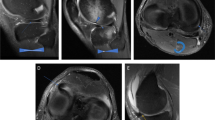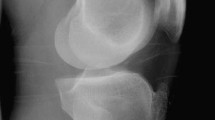Abstract
Objectives
Our purpose was to identify imaging characteristics of tenosynovial and bursal chondromatosis.
Materials and methods
We retrospectively reviewed 25 pathologically confirmed cases of tenosynovial (n = 21) or bursal chondromatosis (n = 4). Patient demographics and clinical presentation were reviewed. Imaging was evaluated by two musculoskeletal radiologists with agreement by consensus, including radiography (n = 21), bone scintigraphy (n = 1), angiography (n = 1), ultrasonography (n = 1), CT (n = 8), and MR (n = 8). Imaging was evaluated for lesion location/shape, presence/number of calcifications, evidence of bone involvement, and intrinsic characteristics on ultrasonography/CT/MR.
Results
Average patient age was 44 years (range 7 to 75 years) with a mild male predilection (56%). A slowly increasing soft tissue mass was the most common clinical presentation (53%). Lesion locations included the foot (n = 8), hand (n = 6), shoulder (n = 3), knee (n = 2), ankle (n = 2) and one each in the upper arm, forearm, wrist, and cervical spine. All lesions were located in a known tenosynovial (21 cases, 84%) or bursal (four cases, 16%) location. All cases of bursal chondromatosis were round/oval in shape. Tenosynovial lesions were fusiform (65%) or round/oval (35%). Radiographs commonly showed a soft tissue mass (86%) and calcification (90%). Calcifications were predominantly chondroid (79%) or osteoid (11%) in character with >10 calcified bodies in 48%. CT detected calcifications in all cases. The intrinsic characteristics of the nonmineralized component showed low attenuation on CT (75%), high signal intensity on T2-weighted MR (76%) and a peripheral/septal contrast enhancement pattern (100%).
Conclusions
Imaging of tenosynovial and bursal chondromatosis is often characteristic with identification of multiple osteochondral calcifications (90% by radiographs; 100% by CT). CT and MR also revealed typical intrinsic characteristics of chondroid tissue and lesion location in a known tendon sheath or bursa.





Similar content being viewed by others
References
Davis RI, Hamilton A, Biggart JD. Primary synovial chondromatosis: a clinicopathologic review and assessment of malignant potential. Hum Pathol. 1998;29(7):683–8.
Dahlin DC, Salvador AH. Cartilaginous tumors of the soft tissues of the hands and feet. Mayo Clin Proc. 1974;49(10):721–6.
Fetsch JF, et al. Tenosynovial (extraarticular) chondromatosis: an analysis of 37 cases of an underrecognized clinicopathologic entity with a strong predilection for the hands and feet and a high local recurrence rate. Am J Surg Pathol. 2003;27(9):1260–8.
Lichtenstein L, Goldman RL. Cartilage tumors in soft tissues particularly in the hand and foot. Cancer. 1964;17:1203–8.
Sim FH, Dahlin DC, Ivins JC. Extra-articular synovial chondromatosis. J Bone Joint Surg Am. 1977;59(4):492–5.
Murphey MD, et al. Imaging of synovial chondromatosis with radiologic-pathologic correlation. Radiographics. 2007;27(5):1465–88.
Roberts D, Miller TT, Erlanger SM. Sonographic appearance of primary synovial chondromatosis of the knee. J Ultrasound Med. 2004;23(5):707–9.
Villacin AB, Brigham LN, Bullough PG. Primary and secondary synovial chondrometaplasia: histopathologic and clinicoradiologic differences. Hum Pathol. 1979;10(4):439–51.
Wittkop B, Davies AM, Mangham DC. Primary synovial chondromatosis and synovial chondrosarcoma: a pictorial review. Eur Radiol. 2002;12(8):2112–9.
DeBenedetti MJ, Schwinn CP. Tenosynovial chondromatosis in the hand. J Bone Joint Surg Am. 1979;61(6A):898–903.
Patel MR, Desai SS. Tenosynovial osteochondromatosis of the extensor tendon of a digit: case report and review of the literature. J Hand Surg Am. 1985;10(5):716–9.
Someren A, Merritt WH. Tenosynovial chondroma of the hand: a case report with a brief review of the literature. Hum Pathol. 1978;9(4):476–9.
Bui-Mansfield LT, Rohini D, Bagg M. Tenosynovial chondromatosis of the ring finger. AJR Am J Roentgenol. 2005;184(4):1223–4.
Lynn MD, Lee J. Periarticular tenosynovial chondrometaplasia. Report of a case at the wrist. J Bone Joint Surg Am. 1972;54(3):650–2.
Metha JA, Bignold LP, Pope RO. Intraarticular rupture of digital tenosynovial calcification: an unusual case of acute arthritis of the finger. J Rheumatol. 1999;26(7):1643–4.
Cohen EK, et al. Hyaline cartilage-origin bone and soft-tissue neoplasms: MR appearance and histologic correlation. Radiology. 1988;167(2):477–81.
Murphey MD, et al. From the archives of the AFIP: imaging of primary chondrosarcoma: radiologic-pathologic correlation. Radiographics. 2003;23(5):1245–78.
Chung EB, Enzinger FM. Chondroma of soft parts. Cancer. 1978;41(4):1414–24.
Weiss SW, Goldblum JR. Enzinger and Weiss's soft tissue tumors. In: Weiss SW, editor. Cartilaginous soft tissue tumors. 4th ed. St. Louis: Mosby; 2001. 1632.
Fetsch JF, Miettinen M. Calcifying aponeurotic fibroma: a clinicopathologic study of 22 cases arising in uncommon sites. Hum Pathol. 1998;29(12):1504–10.
Morii T, et al. Clinical significance of magnetic resonance imaging in the preoperative differential diagnosis of calcifying aponeurotic fibroma. J Orthop Sci. 2008;13(3):180–6.
Torreggiani WC, et al. MR imaging features of bizarre parosteal osteochondromatous proliferation of bone (Nora's lesion). Eur J Radiol. 2001;40(3):224–31.
Murphey MD, et al. Pigmented villonodular synovitis: radiologic-pathologic correlation. Radiographics. 2008;28(5):1493–518.
Baker ND, et al. Pigmented villonodular synovitis containing coarse calcifications. AJR Am J Roentgenol. 1989;153(6):1228–30.
Karasick D, Karasick S. Giant cell tumor of tendon sheath: spectrum of radiologic findings. Skeletal Radiol. 1992;21(4):219–24.
Jelinek JS, et al. Giant cell tumor of the tendon sheath: MR findings in nine cases. AJR Am J Roentgenol. 1994;162(4):919–22.
Murphey MD, et al. From the archives of the AFIP: imaging of synovial sarcoma with radiologic-pathologic correlation. Radiographics. 2006;26(5):1543–65.
Acknowledgment
The authors gratefully acknowledge the residents who attend the AFIP radiologic pathology courses (past, present, and future) for their contribution to our series of patients.
Conflict of interest
The authors declare that they have no conflicts of interest.
Author information
Authors and Affiliations
Corresponding author
Additional information
The opinions or assertions contained herein are the private views of the authors and are not to be construed as official or as reflecting the views of the Departments of the Army, Navy, or Defense.
Rights and permissions
About this article
Cite this article
Walker, E.A., Murphey, M.D. & Fetsch, J.F. Imaging characteristics of tenosynovial and bursal chondromatosis. Skeletal Radiol 40, 317–325 (2011). https://doi.org/10.1007/s00256-010-1012-3
Received:
Revised:
Accepted:
Published:
Issue Date:
DOI: https://doi.org/10.1007/s00256-010-1012-3




